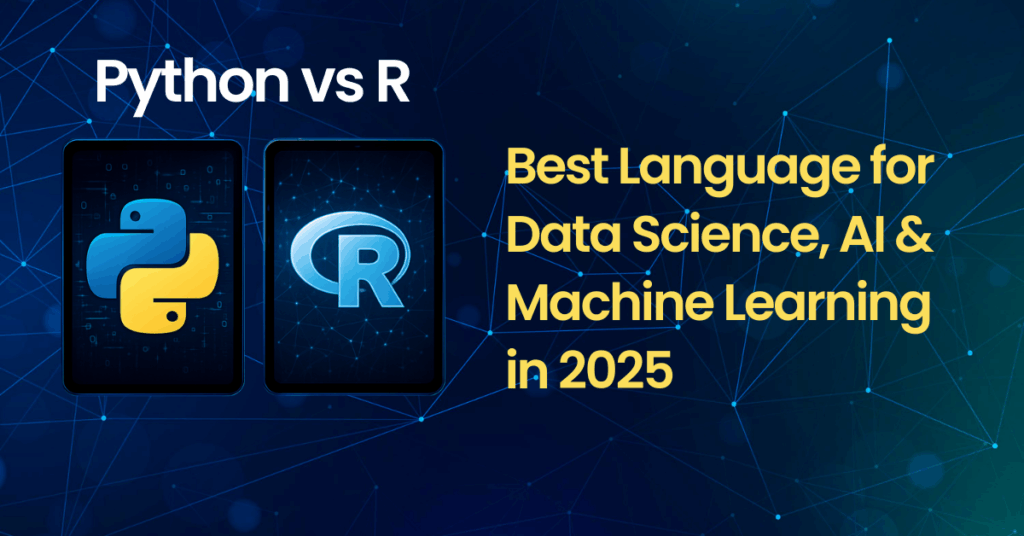
Data science has become one of the most sought-after fields in technology, powering applications in AI, business analytics, and machine learning. Two languages dominate this space: Python and R. Choosing the right one depends on your goals, background, and the type of projects you want to work on. In this article, we’ll break down what Python and R are used for, their key differences, and which might be best for you.
What is Python?
Python is a general-purpose programming language known for its intuitive syntax and ease of use, making it a great choice for beginner programmers. It is widely used in data science, web development, and even gaming. In data science, Python excels in tasks such as data visualization, machine learning, and deep learning. Its large ecosystem of libraries and tools ensures that you can build almost any data-driven solution efficiently.
What is R?
R is a language focused on statistical computing and graphics, often used in business analytics. It is designed for performing complex functions, including statistical tests and models, linear and non-linear modeling, classifications, and clustering. R offers the richest collections of data-science-related packages through the Comprehensive R Archive Network (CRAN). It is also considered the best tool for making beautiful graphs and visualizations, making it popular among statisticians and analysts.
Why Choose Python?
- Easy to learn and beginner-friendly
- Versatile: works for data science, web development, and gaming
- Excellent for data science tasks like data visualization, machine learning, and deep learning
- Rich ecosystem via Python Package Index (PyPi)
Popular Python packages for data science:
- NumPy – numerical computing
- Pandas – data manipulation
- Matplotlib – visualization
- Scikit-learn – machine learning
- TensorFlow – deep learning
Why Choose R?
- Specialized in statistical computing and graphics
- Best for business analytics and complex statistical modeling
- Supports linear and non-linear modeling, classifications, clustering, and statistical tests
- Comprehensive R Archive Network (CRAN) offers extensive packages
- Ideal for creating high-quality visualizations
Popular R packages:
- dplyr – data manipulation
- tidyr – data tidying
- ggplot2 – data visualization
- Shiny – interactive web apps
- Caret – machine learning
Key differences between R and Python
| Feature | Python | R |
| Type | General-purpose programming language | Statistical analysis language |
| Syntax | Intuitive and beginner-friendly | Can be complex, focused on statistical operations |
| Packages | PyPi: NumPy, Pandas, Matplotlib, Scikit-learn, TensorFlow | CRAN: dplyr, tidyr, ggplot2, Shiny, Caret |
| IDE | Jupyter Notebooks, JupyterLab, Spyder | RStudio |
| Strength | Versatile, advanced functionalities, machine learning, AI | Statistics, visualization, business analytics |
Conclusion
Both Python and R are powerful tools for data science and machine learning. Choose Python if you want versatility, beginner-friendly syntax, and strong machine learning capabilities. Choose R if your focus is on statistical analysis, business analytics, and data visualization. You can also use both together for maximum flexibility.
Start by exploring tutorials, practice with datasets, and gradually pick the language that aligns best with your projects and career goals.
Python vs R FAQ’s
1. What is the main difference between Python and R?
Python is a general-purpose programming language, while R is designed specifically for statistical analysis and visualization.
2. Which is easier to learn, R or Python?
Python is generally easier for beginners due to its intuitive syntax. R can be more complex but is powerful for statistical work.
3. Which language is more popular?
Python is more widely used across industries, while R is preferred in academic and research settings.
4. Which language has a better ecosystem for data analysis and machine learning?
Python has a larger ecosystem for machine learning and AI through libraries like TensorFlow and Scikit-learn, while R offers specialized packages for statistical modeling and visualization.
5. Can I use Python and R together?
Yes! Tools like RPy2 and reticulate allow Python and R to work together in a single workflow, leveraging the strengths of both languages.
